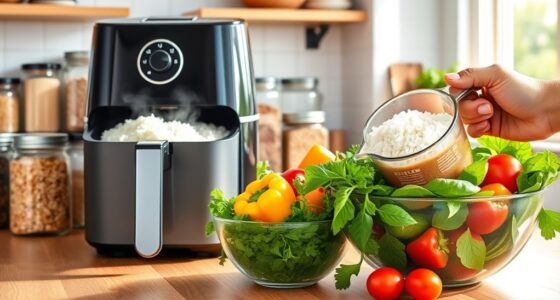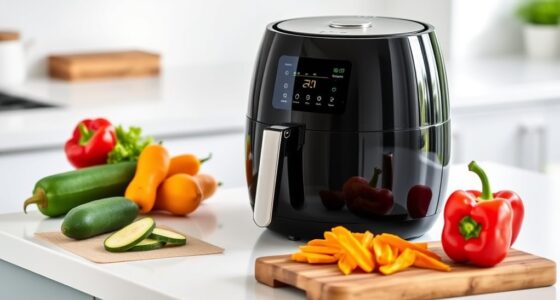Air frying works by circulating rapid, hot air around your food with a powerful fan and precise heat control, creating a convection effect similar to deep-frying but using much less oil. The high-speed circulation helps evaporate moisture quickly, forming a crispy crust while keeping the inside tender. This process combines convection and radiation to heat evenly and efficiently. To discover more about the science behind it, keep exploring how these mechanisms come together.
Key Takeaways
- Air fryers use rapid hot air circulation to mimic deep-frying, creating a convection effect that browns and crisps foods efficiently.
- The streamlined design and powerful fan ensure even heat distribution, preventing hot spots and ensuring uniform cooking.
- High-speed airflow accelerates moisture evaporation, forming a crispy exterior while preserving tenderness inside.
- Precise temperature control maintains consistent heat, optimizing Maillard reactions and nutrient preservation during cooking.
- Combining convection heat transfer with minimal oil results in healthier, faster, and evenly crisped foods with reduced harmful compounds.
The Basics of Air Fryer Design

Air fryers are designed to cook food quickly and evenly by circulating hot air around it. They typically feature a compact, box-like structure with a heating element and a powerful fan. The heating element generates high temperatures, while the fan disperses the hot air in a rapid, uniform motion. This combination creates a convection effect that cooks food from all sides simultaneously. Most models include a removable basket or tray to hold the food, allowing air to flow freely around it. The design often incorporates simple controls for temperature and timer settings, making it easy to operate. Overall, the streamlined layout maximizes airflow and heat transfer, enabling fast cooking without the need for much oil. Additionally, the design’s focus on airflow management ensures consistent results and energy efficiency during operation. The efficient circulation of hot air not only reduces cooking time but also contributes to the healthier cooking benefits associated with air frying. Proper maintenance of the filter systems can help sustain optimal airflow and prolong the lifespan of the appliance.
How Hot Air Circulation Creates Crispy Texture

As hot air circulates rapidly around your food, it causes moisture on the surface to evaporate quickly, leading to a dry, crisp exterior. This rapid evaporation creates a barrier that prevents moisture from escaping the interior, helping your food stay tender inside. The high temperature and continuous airflow promote Maillard reactions, which develop the browning and complex flavors associated with crispiness. As the hot air moves evenly around your food, it ensures all sides are exposed to heat equally, resulting in a uniform crust. The circulation also helps remove excess moisture, preventing sogginess. This combination of moisture removal, even heat distribution, and chemical reactions is what creates that satisfying crispy texture you love in air-fried foods. Additionally, hot air circulation is essential for optimizing cooking efficiency and ensuring consistent results. Incorporating design thinking principles, such as iterative testing and user feedback, can further improve air fryer technology for better culinary outcomes. Recognizing the importance of creative practice in developing innovative cooking appliances can lead to more effective and user-friendly designs.
The Role of Rapid Air Technology
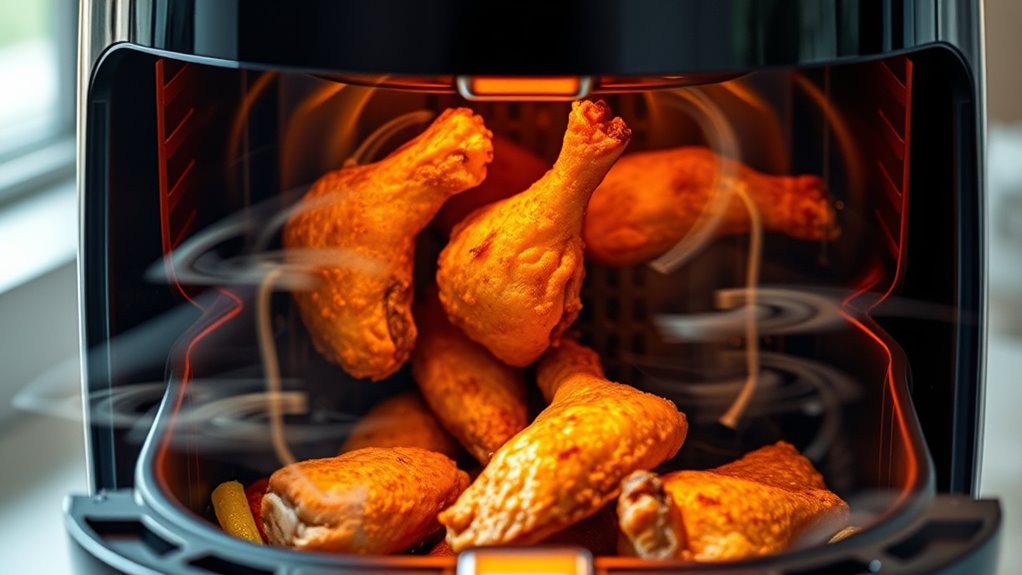
Rapid air technology circulates hot air quickly around your food, ensuring even cooking. This process helps create a crispy texture without needing much oil, making your meals healthier. By reducing oil, you get the same satisfying crunch with fewer calories. Additionally, the technology mimics water park slides in how it swiftly moves air, providing an efficient and fun way to cook your favorite foods. Understanding glycolic acid’s exfoliating properties can also enhance your skincare routine, complementing the benefits of healthier cooking methods. Proper circulation of air also depends on understanding cookie management to optimize the cooking environment and user experience. Mastering airflow patterns is crucial for achieving consistent results and preventing uneven cooking.
Circulating Hot Air
Ever wondered how air fryers achieve that crispy texture with less oil? It all comes down to circulating hot air. Your appliance uses a powerful fan to move heated air rapidly around the food, creating a convection effect. This continuous movement guarantees every surface receives even heat exposure, cooking the food uniformly. As the hot air circulates, it transfers heat efficiently, cooking the exterior quickly while sealing in moisture. This process also promotes the Maillard reaction, which gives your food that desirable golden-brown color. The rapid air circulation replaces traditional frying’s need for large amounts of oil, making your meals healthier without sacrificing crunch. By constantly moving hot air, your air fryer ensures consistent, crispy results with less oil and less mess.
Crispy Texture Formation
The key to achieving that irresistible crispy exterior lies in the rapid air technology of modern air fryers. This technology circulates hot air at high speeds, creating a thin, intense layer of heat around your food. As the hot air moves rapidly, moisture on the surface evaporates quickly, which promotes the Maillard reaction—a chemical process that browns proteins and sugars, forming a crisp, golden crust. The fast circulation ensures even exposure to heat, preventing sogginess and fostering uniform crispiness. Because the process relies on airflow rather than oil, the exterior becomes crisp without becoming greasy. This rapid air movement effectively mimics deep frying’s crispiness, giving you that satisfying crunch with less fat and healthier results. Additionally, understanding the best appliances can help you maximize the benefits of rapid air technology. For optimal results, selecting a Vetted – Flat Iron Bike can ensure consistent performance and durability of your air fryer. Moreover, the design of the circulation system plays a crucial role in achieving consistent cooking outcomes, making it a vital factor to consider when choosing your appliance.
Reduced Oil Usage
Air fryers leverage rapid air technology to markedly reduce the amount of oil needed for cooking. Instead of submerging food in oil, you use just a small spritz or a light brushing. The powerful fan circulates hot air at high speeds, creating a crisp exterior similar to frying but with minimal fat. This rapid air movement promotes even browning and texture, eliminating the necessity for dunking food in large amounts of oil. As a result, you enjoy healthier meals without sacrificing flavor or crunch. By reducing oil, air fryers help lower calorie intake and saturated fat consumption, making your favorite fried foods more nutritious. Overall, this technology allows you to achieve the same satisfying results with considerably less oil, promoting better health without compromising taste.
Convection vs. Air Frying: Understanding the Differences

Although convection ovens and air fryers both use hot air to cook food, they operate differently in ways that can affect your results. Convection ovens are larger and use a fan to circulate hot air around the entire oven, cooking multiple items at once and providing even heat distribution. Air fryers, on the other hand, are compact devices with a powerful fan and a heating element close to the food, creating rapid air circulation that mimics deep frying. This focused design results in faster cooking times and crispier textures for smaller batches. While both rely on convection heat, the air fryer’s concentrated airflow and smaller size allow for more efficient and quicker cooking, often producing crispier results with less oil. Essential oils are often used in air fryers to add flavor or aroma, demonstrating how specialized components can enhance cooking experiences. Additionally, the design of air fryers enables better oil reduction, making them a healthier alternative to traditional frying methods. The rapid circulation also helps in even heat distribution, which contributes to consistent cooking results. Moreover, the compact size of air fryers makes them ideal for small kitchens and quick meal preparations, emphasizing their convenience.
The Impact of Temperature Control on Cooking Results

When you control the temperature precisely, your food cooks evenly and reaches the perfect doneness. Consistent heat prevents hot spots, ensuring every bite is just right. Mastering temperature regulation makes a noticeable difference in your air frying results. Additionally, maintaining precise temperature control can help prevent overcooking or undercooking, leading to more reliable and satisfying cooking outcomes. Proper temperature regulation is especially important when cooking delicate items that require exact heat levels for optimal texture and flavor. Furthermore, understanding the nutritional impact of temperature settings can help preserve the food’s vitamins and antioxidants, ensuring healthier results.
Precise Heat Regulation
Have you ever wondered how precise temperature control can transform your cooking results? With accurate heat regulation, your air fryer maintains consistent temperatures, ensuring each dish cooks perfectly. When you set a specific temperature, the appliance’s sensors adjust the heating element instantly, preventing fluctuations that could lead to uneven cooking or burning. This level of control allows you to fine-tune the heat for different foods, from crispy fries to tender chicken. Precise heat regulation also reduces cooking time, saving energy and preventing overcooking. Proper sizing of heat pumps can be critical in maintaining efficient temperature control within your appliance. By maintaining a stable temperature, your dishes develop better textures and flavors. Additionally, understanding air purifier maintenance principles can help you keep your kitchen environment healthy and safe. Knowing how thermal regulation systems function can further enhance your ability to troubleshoot and optimize your appliance’s performance. Ultimately, this technology empowers you to achieve restaurant-quality results at home, making your air fryer a reliable tool in your kitchen.
Even Cooking Distribution
Precise heat regulation guarantees that your air fryer distributes heat evenly across your food, preventing hot spots and cold zones. When temperature control is accurate, each part of your dish cooks at the same rate, resulting in consistent textures and flavors. This even distribution minimizes the risk of overcooked edges or undercooked centers, saving you time and ensuring better results. The fan and heating element work together to circulate hot air uniformly, maintaining stable temperatures throughout the cooking process. As a result, you get crispy exteriors and juicy interiors without having to flip or rotate your food constantly. Proper temperature control not only improves cooking quality but also enhances safety by reducing the chances of uneven heating that could cause foodborne illnesses. Additionally, consistent heat distribution can help prevent hot spots that may lead to burnt areas or uneven cooking.
Maillard Reaction and Browning in Air Frying
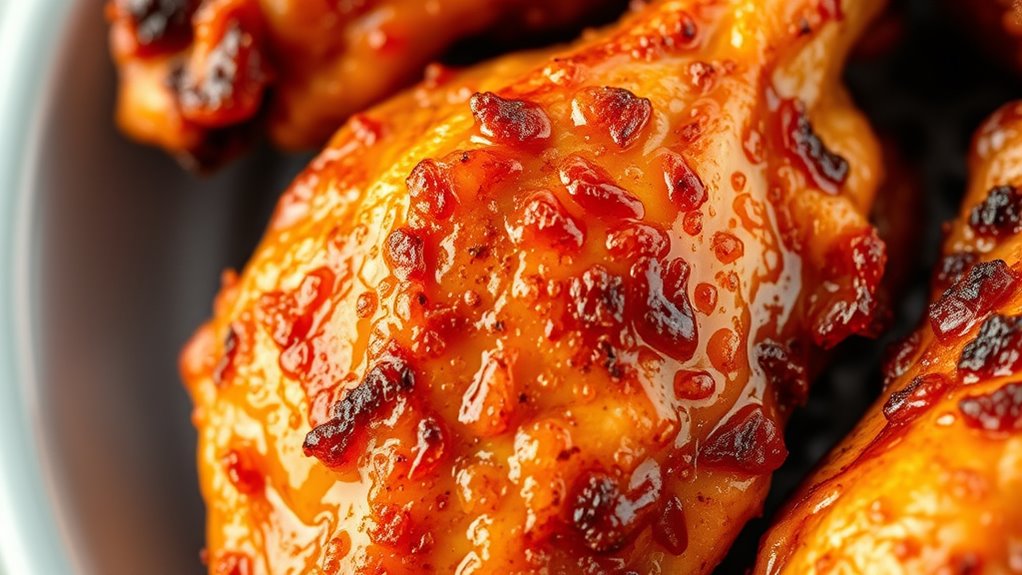
The Maillard reaction is a essential process that gives air-fried foods their appealing golden-brown color and rich flavor. When you cook at high temperatures, amino acids and sugars react, creating complex molecules that develop that savory aroma and crispy exterior. In an air fryer, the rapid circulation of hot air accelerates this reaction, resulting in browning without needing much oil. You’ll notice that foods like fries, chicken, and vegetables turn beautifully crisp and flavorful. The temperature range for the Maillard reaction is typically between 280°F and 330°F, which air fryers easily reach. This browning process not only enhances visual appeal but also intensifies taste, making your air-fried dishes more appetizing and satisfying.
The Significance of Oil in Air Frying
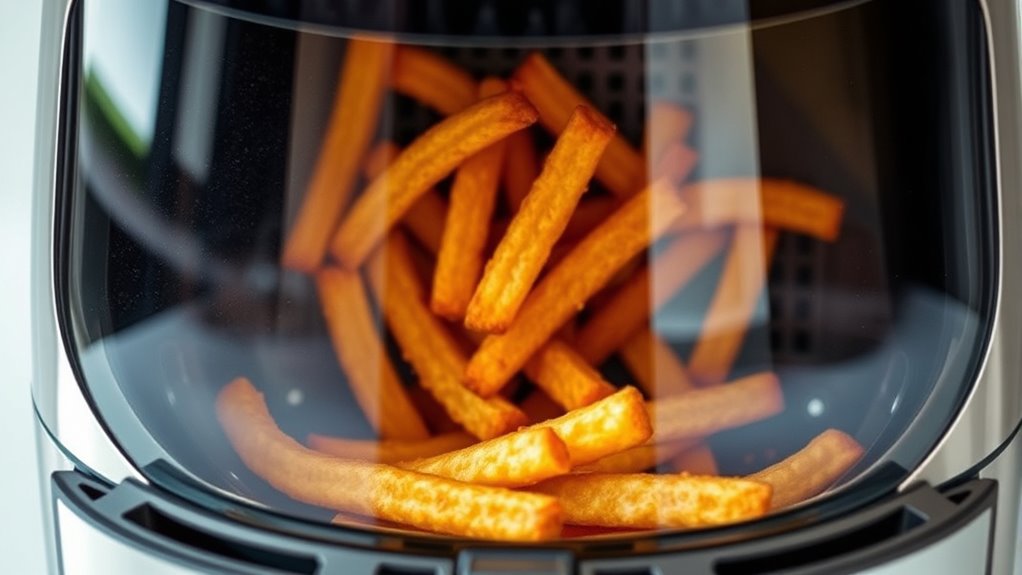
While air fryers are often marketed as low-oil cooking appliances, a small amount of oil can substantially enhance the texture and flavor of your dishes. A light coating helps achieve crispness, boosts browning, and adds richness. The right type and amount of oil can make a noticeable difference without adding excess calories. For example, tossing vegetables with a teaspoon of olive oil improves their crunch and taste. Use the table below to understand how different oils influence your cooking:
| Oil Type | Smoke Point | Flavor Profile |
|---|---|---|
| Olive Oil | 375°F | Fruity, mild |
| Avocado Oil | 520°F | Neutral, buttery |
| Coconut Oil | 350°F | Slightly sweet |
Adding just a little oil maximizes your air fryer’s potential.
Physics of Heat Transfer in an Air Fryer

You can feel the heat in an air fryer through convection, where hot air moves rapidly around your food. Radiation also plays a role, transferring heat directly from the heating element to the surface. The quick circulation of air guarantees even cooking, giving your food that crispy finish every time.
Convection Air Movement
Convection air movement is the key mechanism that allows an air fryer to cook food quickly and evenly. It works by circulating hot air rapidly around your food through a fan and a heating element. This constant movement guarantees all surfaces of your food are exposed to heat simultaneously, preventing hot spots and uneven cooking. As the fan blows air over the heating element, it creates a steady flow, transferring heat efficiently through convection. This process speeds up cooking times compared to traditional methods. You’ll notice that foods become crispy on the outside while remaining tender inside. Proper air circulation is essential for achieving that desirable fried texture without using excessive oil. Ultimately, convection air movement is what makes your air fryer a fast, efficient, and healthier cooking tool.
Radiation Heat Transfer
In addition to convection, radiation heat transfer plays a significant role in how an air fryer cooks food. The heating element, usually an infrared or quartz heater, emits electromagnetic radiation in the form of infrared waves. These waves travel through the air and directly transfer heat to the surface of your food upon contact. Unlike convection, which heats through circulating hot air, radiation heats objects without needing a medium, making it highly efficient for browning and crisping. When the infrared waves reach the food, they cause molecules on the surface to vibrate rapidly, resulting in heat. This process helps achieve that desirable crispy exterior while maintaining moistness inside. Radiation complements convection, accelerating cooking and enhancing texture in your air-fried dishes.
Rapid Air Circulation
How does an air fryer cook food so quickly and evenly? It uses rapid air circulation to transfer heat efficiently. A powerful fan blows hot air around the food at high speed, creating a convection effect. This continuous movement ensures all surfaces are exposed to the same heat, reducing cooking time and promoting even browning. The rapid air movement also helps evaporate moisture quickly, resulting in a crispy exterior similar to deep-frying but with less oil. Because the hot air circulates rapidly, heat penetrates the food uniformly, preventing cold spots or uneven cooking. This physics principle makes air frying faster and more consistent, allowing you to prepare crispy, delicious dishes efficiently.
How Food Composition Affects Cooking Outcomes

The composition of your food considerably influences how it cooks in an air fryer. Foods high in fat, like bacon or oily fish, tend to crisp quickly because the fat helps conduct heat and promotes browning. On the other hand, foods with high moisture content, such as vegetables or lean meats, may require longer cooking times to evaporate water and develop a crispy exterior. Breading and batter also affect the outcome; a light coating promotes even browning, while thick breadings can trap moisture and slow crisping. Additionally, the density and size of food items matter—smaller pieces cook faster and more evenly, while larger cuts may need more time. Understanding these factors helps you optimize cooking times and achieve better results in your air fryer.
Benefits of Air Frying From a Scientific Perspective
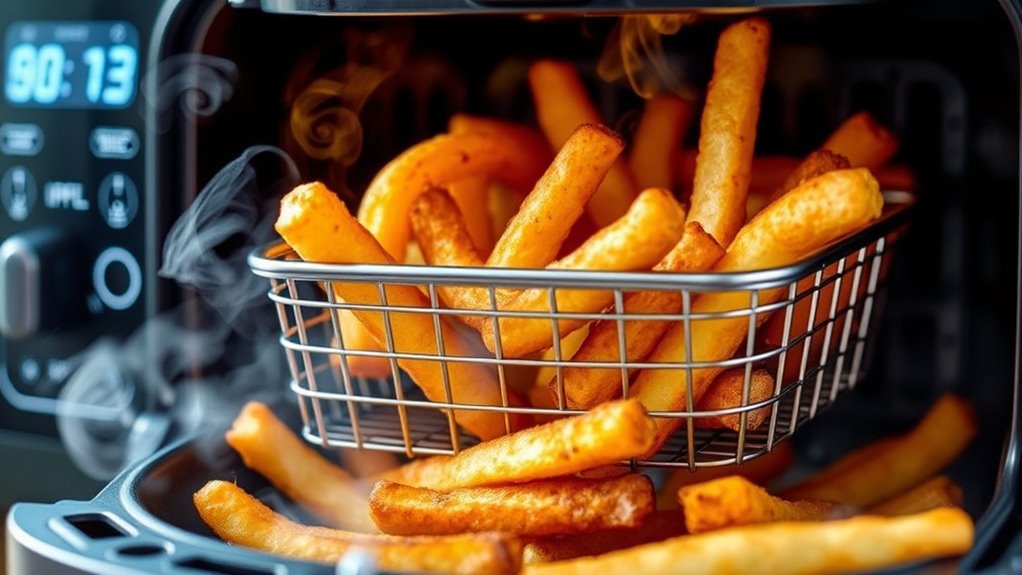
Air frying offers several scientifically backed benefits that improve cooking efficiency and health. Because it uses rapid air circulation, food cooks evenly and quickly, reducing overall cooking time. This method minimizes nutrient loss compared to traditional frying, helping preserve vitamins and minerals. Additionally, air frying requires markedly less oil—often just a spray or a teaspoon—lowering your intake of unhealthy fats and calories. The high heat and fast cooking also create a crispy texture without the need for excessive oil, which can decrease the formation of harmful compounds like acrylamide. Overall, air frying allows you to prepare healthier meals efficiently, with fewer calories and preserved nutrients, making it a smarter choice for health-conscious cooking.
Frequently Asked Questions
How Does Air Fryer Temperature Affect Nutrient Retention?
You might wonder how temperature impacts nutrient retention in your air fryer. When you cook at higher temperatures, some nutrients, like vitamins, can break down faster. Cooking at moderate temperatures helps preserve more nutrients while still giving you crispy, delicious results. So, by adjusting your air fryer’s temperature, you control nutrient loss and enjoy healthier, flavorful meals without sacrificing texture or taste.
Can Air Frying Reduce Harmful Acrylamide Formation?
Ah, the age of air frying! You’ll be glad to know it can indeed reduce harmful acrylamide formation. By cooking at lower temperatures and for shorter times, you limit the browning that creates acrylamide in starchy foods. This means you get crispy results without the health risks associated with traditional frying. So, next time, opt for your air fryer to enjoy snacks that are both tasty and safer!
Why Does Food Sometimes Stick Despite Minimal Oil Use?
You might notice food sticking despite using little oil because of several factors. Insufficient oil can cause food to adhere to the basket or tray, especially if it’s not properly coated or preheated. Additionally, high moisture content or uneven heat distribution can lead to sticking. To prevent this, lightly brush or spray the food with oil, preheat the air fryer, and avoid overcrowding, ensuring even cooking and minimal sticking.
How Does Food Size Influence Cooking Time and Crispiness?
Imagine small, evenly-sized food pieces dancing in your air fryer; they cook faster and crisp up more uniformly. Larger chunks take longer, absorbing more heat and needing extra time to reach that perfect crunch. To get consistent results, cut your food into similar sizes. Smaller pieces maximize crispiness and reduce cooking time, while bigger ones require patience, ensuring each piece is thoroughly cooked and delightfully crispy.
What Are the Limitations of Air Frying for Different Food Types?
You should know that air frying has limitations with certain foods. For example, wet batters don’t crisp well and can stick to the basket, while large or densely packed items may not cook evenly or thoroughly. Thin cuts might burn easily, and delicate foods like cheese can melt or break apart. Understanding these constraints helps you choose suitable foods and adjust cooking times for better results.
Conclusion
Understanding how air fryers work helps you cook healthier meals with less oil. Did you know that air frying can reduce fat content by up to 75% compared to traditional frying? By mastering the science behind rapid air circulation and heat transfer, you can achieve perfectly crispy results every time. Next time you use your air fryer, remember you’re harnessing physics to enjoy delicious, guilt-free food with a fraction of the oil.

